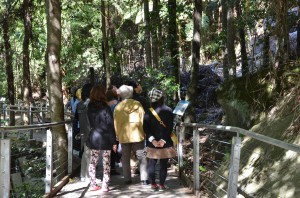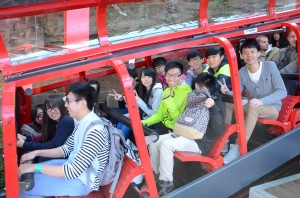Editor’s Note: Amanda Byrne is head of Marketing & Events at Scenic World, a privately owned attraction in Australia’s Blue Mountains. Scenic World has made smart and deliberate changes to cater to Chinese travelers -- its fastest growing inbound market -- including participating in specific training from a program called China Ready and Accredited. ATTA asked Byrne to tell us about these changes and what impact they’ve had so far on business.
 Can you describe the China Ready and Accredited Program? What kinds of actions, both operational and marketing, did this training lead you to?
Can you describe the China Ready and Accredited Program? What kinds of actions, both operational and marketing, did this training lead you to?
China Ready and Accredited (CRA) is an Australian initiative but a global organisation essentially offering training and accreditation. Their aim is to provide Chinese consumers with an assurance of service quality, when choosing service providers outside mainland China. Domestic travelers in mainland China are used to a quality rating system not just for accommodation but also for tourism experiences, dining and shopping. CRA plans to create this system globally for Chinese international travelers to assist with their travel decisions. From a tourism point of view they also keep on top of Chinese tourism related legislation and how this impacts international travel trends.
They also offer a variety of training programs to help educate operators about Chinese culture, likes and dislikes and what influences their buying decisions. Much of it is very practical training suitable to all levels of operators but they also offer industry sector and CEO training.
Because China is our biggest inbound market, it confirmed a lot of what we had already worked out about this rapidly expanding market but also highlighted a few new things. We learnt about influencers for purchasing such as lucky (and unlucky) numbers and colours, concerns around safety, strong national interest in ‘health and wellbeing’, and cultural relevance of nature and world heritage-listed sites. This kind of information helped us tailor our retail offering for the China market, creating onsite activations around Chinese New Year and targeting our marketing in the lead up to national holidays when international travel is high.
Can you share any highlights or challenges you encountered while making these shifts to cater to inbound Chinese travelers?
We have been hampered by changes in Chinese tourism legislation which resulted in a decline in group travel for a few months. The legislation change impacted how international group bookings can be made. It’s important to be able to be responsive to the market and flexible in adapting your product to fit international government changes you have no control over. We met with many operators to work out the issues they were experiencing on the ground in China and we were able to work together to adjust our offering to suit this new legislation.
Accommodating China Union Pay, the preferred payment option for Chinese travelers, has been critical for you to meet the demand of Chinese inbound tourism. How do you recommend tour operators or destinations deal with this hurdle if this capability doesn’t exist?
China Union Pay is now bigger than Visa and works as both a credit and debit card. When Chinese nationals travel they can only take $5000 USD out of the country, which is why we made it a priority to accept CUP. For destinations and operators who don’t have the option of accepting CUP, I suggest trying to make services purchasable online as much as possible before they arrive so they are not having to spend their limited cash onsite.
Can you briefly describe what your initial success has looked like in enticing more Chinese travelers? What kinds of new travelers have been coming to Australia since the changes?
The major markets we have attracted are group travellers and Independent VFR (Visit Friends and Relatives). Australia has a large Chinese student population and culturally it is their responsibility to help their visiting friends and families decide what they should see and experience during their visit. The VFR market tends to be middle class/luxury. The group market consists of both budget and middle class. We have also seen an increase in Incentive Travel – where large corporations are treating their staff to an international holiday (we have an incentive group of 6,000 coming to the Blue Mountains in September 2014). These groups tend to have lots of disposable income to spend as they are not paying for their travel/accommodation/experiences etc.
 Aside from instituting operational changes and getting involved on Chinese social media sites, have you used any other campaigns or partnerships to market to and develop this audience?
Aside from instituting operational changes and getting involved on Chinese social media sites, have you used any other campaigns or partnerships to market to and develop this audience?
We have partnered with China Union Pay on a promotional campaign, which offered us exposure on their website, social media channels and newsletters in mainland China. We also make regular sales visits to China to meet with operators and see first hand what is happening on the ground. This really is our core sales and marketing strategy: nothing works better than face-to-face. We of course also work closely with local, state and national tourism bodies who have forged relations with China to share information and trends.
How do you use social media marketing to reach a Chinese audience? Specifically, how do you use the Chinese site Weibo?
We use a Chinese national marketing consultant to run our Weibo campaign and it probably takes about a quarter of the time we spend on other western social platforms. Just like Facebook, algorithms for tracking and functionality are changing all the time so it can be challenging. It’s all in Mandarin, so you do need a Chinese speaker to help you translate and understand interactions. We use the platform mostly to promote our destination and also promote product information and test what resonates with those markets so we can tailor the messaging. For example we ran a poll around some new menu items we were looking at trialling for the Chinese market and we were able to select two clear winners which we now sell well in our food outlet.
How is consumer behavior and brand interaction different on Weibo than on European or North America social sites such as Facebook?
Both Facebook and Weibo have three major functions for followers: like, comment, share. The most used function in Facebook is ‘like’, which encourages the post/comment without too much effort, but it’s also a very important key performance indicator for advertisers. In Weibo this function is not commonly used; when users read something they like the most common action used is ‘retweet’ or to share with their friends. Another difference is that Facebook users create their own updates with original content, but in Weibo most people create very little content and only share others, so as an organisation there is an opportunity to create relevant interesting ‘retweetable’ content. Also, Facebook users are more likely to post directly about your organisation, using ‘@’. On Weibo you need to be more proactive monitoring your keywords in their system and interact with them, rather than wait for users to refer to you.
You mention that understanding health impacts around products is key for the Chinese - what does this mean?
Chinese travellers like to know how something will make them feel - what positive health impacts they will experience. When we describe our experiences we talk about how the ‘fresh mountain air will make you feel rejuvenated’ or how our locally made honey is good for colds and sore throats and boosting your immune system.
The cultural interest around lucky numbers and colors is important to outbound travelers from China. How do you incorporate that into the experiences you are offering?
We make sure our price points for Chinese products are based around lucky numbers and use lucky colours for packaging, etc - and avoid unlucky numbers and colours. Its also good to be aware of these cultural differences. For example, in some of our earlier website designs we were advised that there was too much black in our design which represents mourning/loss. Obviously you need temper this in relation to the size of your Chinese markets versus other markets.
Your success has been at the attraction level. Given what you've learned, what top three pieces of advice would you give tour operators or small destinations looking to attract and cater to Chinese travelers?
- Cultural awareness– learn about your potential customer and understand why they behave the way they do.
- Nuance your marketing – think about your product and what you have learnt about your market – and tailor your messaging.
- Be flexible – China is an incredibly responsive and adaptive market, be open to adapting your product or booking processes.
